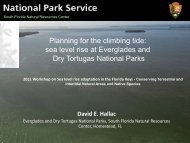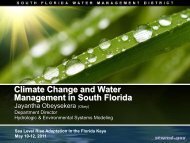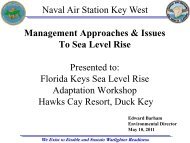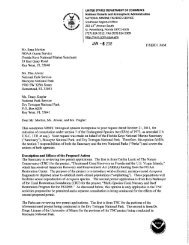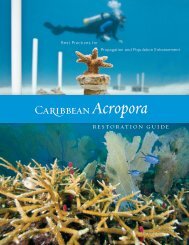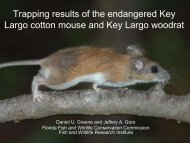Caribbean Acropora Restoration Guide - The Florida Reef ...
Caribbean Acropora Restoration Guide - The Florida Reef ...
Caribbean Acropora Restoration Guide - The Florida Reef ...
Create successful ePaper yourself
Turn your PDF publications into a flip-book with our unique Google optimized e-Paper software.
Chapter 4 | Case Studies<br />
Coral Collections<br />
• Fragments were collected from healthy wild colonies. When possible, naturally broken corals from<br />
these wild colonies were chosen.<br />
Nursery Operations and Maintenance<br />
• Regular cleaning – algae.<br />
• Size monitoring every two months.<br />
• Because of the materials chosen, there is no need to change degraded materials.<br />
• <strong>The</strong> nursery was initially deployed in three different reef areas. Survivorship results indicated the best<br />
site, where 100 more concrete blocks are planned to be deployed.<br />
• <strong>The</strong> inland nursery requires more attention for cleaning, feeding and monitoring for disease.<br />
<strong>The</strong> main purpose of this nursery is to evaluate if it is possible to accelerate growth with more food<br />
(Artemia nauplii).<br />
Outplanting<br />
• 60 corals from the inland nursery were attached to a concrete block at the in-water nursery after 11<br />
months in aquarium conditions (July 2011).<br />
• Outplanting from the in-water nurseries is scheduled for Fall 2011.<br />
• Outplanting sites are located in Isla Mujeres Bay, near two of the nurseries.<br />
• Both sites selected for the outplanting were impacted earlier by boat groundings.<br />
• <strong>Acropora</strong> colonies are already present at both sites.<br />
Lessons Learned<br />
Collect healthy corals. Survivorship of corals that were collected from the bottom was not as high. Although they<br />
were naturally broken, they may not have been healthy enough to support further fragmentation.<br />
Evaluate your options. Several designs were used during outplanting to attach the corals, but the best used PVC<br />
connectors, which can be screwed on or out easily.<br />
Spread your risk. Nurseries were placed in different areas of the reef. One nursery was located near the reef crest,<br />
which was thought to be a good area. This nursery had less than 70% survivorship. This was likely due to poor<br />
water quality, since patches of yellow turf algae were seen around the site.<br />
35



